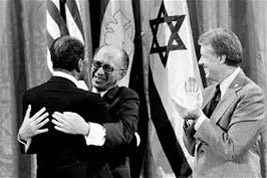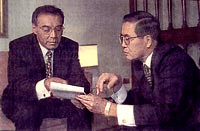Separating the People from the Problem in a Negotiation
By Chuck Doran, Mallory Minter and Megan Winkeler

Every negotiation is comprised of two major components: the people taking part in the negotiation and the problem those people need to address. Roger Fisher, William Ury, and Bruce Patton introduced the idea of separating the people from the problem in their book Getting to Yes: Negotiating Agreement Without Giving In:
“If negotiators view themselves as adversaries in a personal face-to-face confrontation, it is difficult to separate their relationship from the substantive problem. In that context, anything one negotiator says about the problem seems to be directed personally at the other and is received that way. Each side tends to become defensive and reactive and to ignore the other side’s legitimate interests altogether.”
When we turn our negotiating counterpart into the enemy, we tend to lose focus on resolving the problem. If we can separate our dislike, maybe even hatred, of the other side from our goal to resolve the problem at hand, we become more effective at negotiating deals that are in our best interest.
This is where most people nod and think, “This sounds great – except for my dispute with Carl. Carl is just a bad person, and I cannot negotiate with him.” To encourage you to try separating people from the problem – even with Carl – consider the following examples of world leaders overcoming incredible differences and years of deeply embedded conflict to negotiate sustainable solutions.
Egypt-Israel Peace Treaty
In 1979, President Anwar el-Sadat of Egypt and Prime Minister Menachem Begin of Israel signed the Egypt-Israel Peace Treaty, signaling the end of a conflict that damaged the region for decades. Famously facilitated by President Jimmy Carter during the Camp David Peace Accords, the nations agreed to demilitarize the Sinai Peninsula and allow free passage through the Suez Canal and other international waterways. Egypt also agreed to recognize Israel as a state.
According to President Sadat, the facilitation of this treaty “constitutes one of the greatest achievements of our time.” Beyond the years of religious and ethnic-conflict between the two nations, it was well known that President Sadat personally did not like Prime Minister Begin and that strong differences existed between both leaders.
Nevertheless, with the help of President Carter, President Sadat and Prime Minister Begin separated their political relationship from their substantive problems and designed an agreement that allowed their nations to move past enduring military conflict.
Brasilia Presidential Act
In 1998, between President Jamil Mahuad of Ecuador and President Alberto Fujimori of Peru signed the Brasilia Presidential Act, ending the Western Hemisphere’s longest running territorial dispute between the two nations. Prior to negotiation, President Mahuad, a former student of Roger Fisher, invited Fisher to Ecuador to get advice on how to approach the negotiation with President Fujimori. In response, Fisher encouraged President Mahuad to build a working relationship with Fujimori.
 In particular, Fisher encouraged President Mahuad to arrange to have a photograph made of the two men. However, he stipulated that this photo should not be of President Mahuad and President Fujimori looking at each other and shaking hands, as is often the case when politicians take photos during an agreement process. Rather, this photo should be of President Mahuad and President Fujimori sitting side-by-side, looking at a writing pad on which they are both working.
In particular, Fisher encouraged President Mahuad to arrange to have a photograph made of the two men. However, he stipulated that this photo should not be of President Mahuad and President Fujimori looking at each other and shaking hands, as is often the case when politicians take photos during an agreement process. Rather, this photo should be of President Mahuad and President Fujimori sitting side-by-side, looking at a writing pad on which they are both working.
This photo, published in the newspaper the day after it was taken, symbolizes the idea of separating the people from the problem. Despite 50 years of warfare between the two countries, Mahuad and Fujimori – both in the photo and during the negotiation – demonstrated the act of separating their political relationship, defined by turmoil, from the substantive border problem in need of a solution.
Consequences
As difficult as it may be, separating the people from the problem is critical to the success of a negotiation. When a negotiator expresses negative relational feelings through hostile or emotionally-charged actions, the other party may begin to feel attacked and/or uncomfortable in the negotiation process. Trust, communication, and patience between negotiators dwindle, leading both negotiators to seek a swift end instead of a quality solution from the process. In the end, no one comes away fully satisfied with the negotiation process or the result.
Failing to separate the people from the problem also has long-term consequences. For example, if two negotiators have a bad encounter and meet again later – either inside or outside of a negotiation setting – chances are the exchange will be less than optimal. If they meet inside of a negotiation setting, it is likely that they will revert to the same quick, tempered, and inefficient negotiation process as the one before.
Negotiation Tips
To successfully separate the people from the problem, consider the following tips.
- Treat every relationship as a long-term relationship. You never know when someone you are negotiating with might make subsequent appearances in your work life, or become your next-door neighbor. The point here is that no one can fully predict the future, including when and how you might need to work with someone in the future. So, to make life easier on yourself and others, imagine that every relationship you encounter is a long-term relationship. This is guaranteed to help your negotiations – and your life – run smoother;
- Model respectful behavior, regardless of how you are being treated. If the other negotiator articulates an insulting slur, do not do the same. Rather, turn the other cheek and continue on with the negotiation, or address the comment in a manner that is respectful and that prioritizes both the negotiators’ relationship and the negotiation process. If you model this respectful behavior and clearly establish that the objective of this negotiation is to address the problem, your fellow negotiator will likely also come to see that (1) his/her personal slurs are ineffective and/or (2) he/she is thwarting the development of a solution for both of you;
- Try to frame yourself, and see the other, as an ally with whom you are working with against a mutual problem. If you see your fellow negotiator as an ally, you mentally place yourself on their same team. This minimizes the tendency for you and the other negotiator to villainize each other. Framing yourself as an ally also encourages collaboration, making you more accommodating to your counterpart and, in return, your counterpart more accommodating to you;
- Try to remember ‘Be hard on the issues, not on the people.’ Use this insightful tip to replace any negative mantra running through your head. This tip embodies the idea of separating the people from the problem. Focus on the issues and make sure that they are fully addressed, but go easy on the people. They are the ones you must work with to best address the issues, and they may be people you will need to work with well into the future;
- If appropriate, set ground rules that vocally prioritize the relationship. This can be a very helpful tool! If both negotiators agree at the onset to prioritize their relationship, then this ground rule can be referenced in any future instance where one negotiator feels like the negotiation is turning into a personal attack. Furthermore, since both negotiators must agree to this ground rule at the onset, it primes the negotiation to be a successful process that focuses on the issues and not on the people;
- Avoid trading the relationship for the substance. If you find yourself in a position where the other negotiator is covertly asking you to trade something of substance in order to maintain a good relationship with them or their organization, stop. Think hard before you decide to give up one of your interests in order to maintain a good relationship with your counterpart. While this may result in a better long-term relationship, it may just as likely result in a relationship where the other believes that you can be easily taken for a ride. Likewise, you should also avoid making a proposition that trades relationship for substance. While you may receive a concession this way, the implementation of the deal and the relationship between negotiators will suffer.
When interests and emotions are high, it is easy to turn a negotiation into a boxing ring where you want nothing more than to defeat the other person – and possibly bruise their reputation and self-esteem in the process. Avoid this. In the end, such actions will only lead to a lousy negotiation deal and a tarnished relationship between negotiators. Instead, prioritize the relationship shared between negotiators, separate the people from the problem, and act in a manner that clearly communicates your priorities to your fellow negotiator. This will ensure a smoother negotiation process – from conception to implementation – and will help maintain a strong working relationship between negotiators.
We’d love to hear your thoughts about this article in the comments section below.


